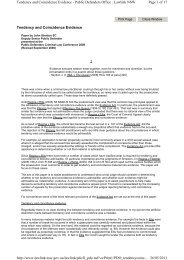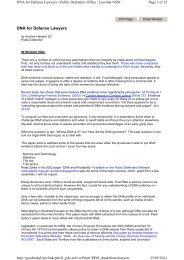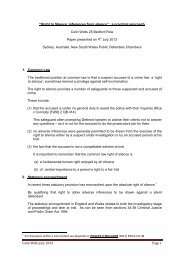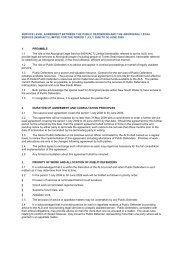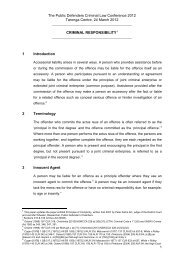Expert Evidence, by Dina Yehia SC - The Public Defenders
Expert Evidence, by Dina Yehia SC - The Public Defenders
Expert Evidence, by Dina Yehia SC - The Public Defenders
Create successful ePaper yourself
Turn your PDF publications into a flip-book with our unique Google optimized e-Paper software.
[146] ‘Facial mapping, let alone body mapping, was not shown, on the evidence in the trial,<br />
to constitute ‘specialised knowledge’ of a character which can support an opinion of<br />
identity’.<br />
Although the Court held that the opinion as to identification was inadmissible, training in anatomy, combined<br />
with the fact that the witness had spent time comparing security images with the police reference photographs<br />
led the Court to qualify her as an ‘ad hoc’ expert allowing her to give evidence about similarities between the<br />
persons in the images.<br />
<strong>The</strong> Court adopted a narrow reading of section 79 saying that<br />
[137] ‘[t]he focus must be on the words ‘specialised knowledge’, not on the introduction of an<br />
extraneous idea such as ‘reliability’,<br />
As Gary Edmond points out Tang is not an isolated case. 2 Edmonds cites a number of cases involving facial<br />
mapping or voice identification evidence where evidence was adduced notwithstanding the absence of ‘..a<br />
credible field, supporting literature, validation studies, and information about error rates.’ 3 It appears that the<br />
Courts are unwilling to exclude ‘expert’ evidence pursuant to section 137 or the <strong>Evidence</strong> Act for fear of<br />
trespassing on the role of the jury. Instead, in considering the 137 discretion, the evidence is taken at its<br />
‘highest’, assessment of reliability being left to the jury to decide.<br />
This reluctance <strong>by</strong> the Courts to assess issues of reliability in determining admissibility of expert evidence is<br />
out of step with concerns raised in the scientific community about the role of flawed expert evidence in<br />
wrongful convictions. A 2009 report from the American National Academy of Science (NAS) concludes that,<br />
with the exception of nuclear DNA evidence, most forensic evidence lacks a scientific basis and adequate<br />
regulation and quality control. It proposes a federal program of research together with independent scientific<br />
governance and certification. 4<br />
In many cases expert evidence that suggests ‘similarities’ between a suspect image and CCTV footage or an<br />
exhibit item and a reference item, has little or no probative value and a high degree of unfair prejudice<br />
because of what John Stratton refers to as the ‘white coat effect’.<br />
Raymond George MORGAN v R [2011] NSWCCA 257<br />
<strong>The</strong> appellant was convicted of 5 offences including 2 counts of robbery in company on hotels in Willough<strong>by</strong><br />
and Drummoyne. <strong>The</strong> Crown case relied on circumstantial evidence. CCTV footage from both hotels was in<br />
evidence. <strong>The</strong> Managers from the hotels gave general descriptions of the offenders but on each occasion the<br />
offenders wore balaclavas.<br />
<strong>The</strong> Crown called Dr Henneberg, a biological anthropologist and anatomist who professed to be an expert in<br />
what is loosely referred to as ‘body mapping’. He was tasked to undertake an anatomical comparison of the<br />
CCTV images and images obtained of the appellant during a forensic procedure.<br />
Dr Henneberg concluded:<br />
“Based wholly or substantially on the above knowledge, I am of the opinion that there is a<br />
high level of anatomical similarity between the offender and the suspect (Mr Morgan). My<br />
opinion is strengthened <strong>by</strong> the fact that I could not observe on the suspect any anatomical<br />
detail different from those I could discern from the CCTV images of the offender’.<br />
<strong>The</strong> defence called evidence on the voire dire from Dr Kemp, a senior lecturer in forensic psychology and<br />
Glenn Porter, a forensic scientist.<br />
2 ‘Impartiality,efficiency or reliability? A critical response to expert evidence and procedure in Australia’,<br />
Gary Edmond, Australian Journal of Forensic Sciences, 2010, 1‐17 at p4<br />
3 Ibid at 4; see Regina v Li(2003) 139 A Crim R 281; R v Jung [2006] NSW<strong>SC</strong> 658; Murdoch v <strong>The</strong> Queen<br />
(2007) 167 A Crim R 329; R v El‐Kheir [2004] NSWCCA 461<br />
4 “A Contextual Approach to the Admissibility of the State’s Forensic Science and Medical <strong>Evidence</strong>’, G.<br />
Edmond & Kent Roach, (2011) 61 University of Toronto Law Journal at p 344<br />
9



